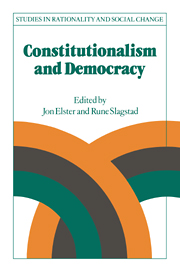Book contents
- Frontmatter
- Contents
- Notes on contributors
- Introduction
- 1 Gag rules or the politics of omission
- 3 Democracy as a contingent outcome of conflicts
- 3 Consequences of constitutional choice: reflections on Tocqueville
- 4 Liberal constitutionalism and its critics: Carl Schmitt and Max Weber
- 5 Democracy and the rule of law: some historical experiences of contradictions in the striving for good government
- 6 Neo-federalism?
- 7 Precommitment and the paradox of democracy
- 8 American constitutionalism and the paradox of private property
- 9 From liberal constitutionalism to corporate pluralism: the conflict over the enabling acts in Norway after the Second World War and the subsequent constitutional development
- 10 Arguments for constitutional choice: reflections on the transition to socialism
- 11 Constitutions and democracies: an epilogue
- Index
Introduction
Published online by Cambridge University Press: 05 June 2012
- Frontmatter
- Contents
- Notes on contributors
- Introduction
- 1 Gag rules or the politics of omission
- 3 Democracy as a contingent outcome of conflicts
- 3 Consequences of constitutional choice: reflections on Tocqueville
- 4 Liberal constitutionalism and its critics: Carl Schmitt and Max Weber
- 5 Democracy and the rule of law: some historical experiences of contradictions in the striving for good government
- 6 Neo-federalism?
- 7 Precommitment and the paradox of democracy
- 8 American constitutionalism and the paradox of private property
- 9 From liberal constitutionalism to corporate pluralism: the conflict over the enabling acts in Norway after the Second World War and the subsequent constitutional development
- 10 Arguments for constitutional choice: reflections on the transition to socialism
- 11 Constitutions and democracies: an epilogue
- Index
Summary
Ten chapters, most of them published here for the first time, make up the bulk of this book. In addition, the editors commissioned an epilogue from Cass Sunstein, to bring out more clearly implicit agreements and disagreements among the contributors, and to engage in a discussion with them. The present introduction has a more limited purpose. It attempts to map some of the main problems raised by the contributors and to bring out their relation to one another. I shall emphasize three issues. First, I shall argue that the tension between constitutionalism and democracy is only, as it were, the two-dimensional projection of a three-dimensional issue. The third dimension which provides depth to that tension is the goal of efficient decisionmaking, unencumbered, if necessary, both by popular participation and by constitutional constraints. Next, I attempt to survey some of the proposed answers to what is perhaps the central question in the volume: why would a society want to limit its own sovereign power? Why would a democratic society tolerate what might appear to be a dictatorship of the past over the present? Finally, I shall explore some of the multiple links, discussed in the chapters below, between democracy, constitutionalism and private property. Is constitutionalism only a tool deployed in the self-interest of the property-holding class? Or are constitutional guarantees for property in the interest of everybody?
A three-cornered dilemma
Democracy I shall understand as simple majority rule, based on the principle “One person one vote.”
- Type
- Chapter
- Information
- Constitutionalism and Democracy , pp. 1 - 18Publisher: Cambridge University PressPrint publication year: 1988
- 11
- Cited by

